|
 
 |
| ORIGINAL ARTICLE |
|
| Year : 2016 | Volume
: 4
| Issue : 1 | Page : 53-59 |
|
Determination of stature from combined maxillary anterior teeth and head dimensions among the Efik and Ibibio of South-South Nigeria
D. E. O. Eboh
Department of Human Anatomy and Cell Biology, Faculty of Basic Medical Sciences, College of Health Sciences, Delta State University, Abraka, Delta State, Nigeria
| Date of Web Publication | 13-Sep-2016 |
Correspondence Address:
D. E. O. Eboh
Department of Human Anatomy and Cell Biology, Faculty of Basic Medical Sciences, College of Health Sciences, Delta State University, P.M.B. 1, Abraka, Delta State
Nigeria
 Source of Support: None, Conflict of Interest: None  | Check |
DOI: 10.4103/2315-7992.190459

Background: Studies on human identification by stature from combined width of maxillary anterior teeth and head dimensions have been carried out for forensic reasons. Materials and Methods: Body height, head circumference, head length, and width were measured in centimeter. Mesiodistal crown widths of central and lateral incisors, as well as canines of both sides, were also measured in centimeter. Statistical Analysis: Statistical analysis was carried using descriptive statistics, t-test, linear multiple regression analyses where P ≤ 0.05 was considered statistically significant. Results: In general, body height, head dimensions, and combined width of maxillary anterior teeth showed males had significantly higher values than females (P < 0.05). In the majority of data studied, the correlations between stature and head dimensions; stature and combined teeth dimension were statistically significant (P < 0.05). Coefficients of correlation were very low and reliability of the models were on the low side in the majority of the data studied. Conclusion: Based on the poor reliability of the models, these parameters can be employed only as supportive tools in stature estimation using regression analyses. Keywords: Forensic anthropology, head dimensions, maxillary anterior teeth, stature estimation
How to cite this article:
Eboh D. Determination of stature from combined maxillary anterior teeth and head dimensions among the Efik and Ibibio of South-South Nigeria. Ann Bioanthropol 2016;4:53-9 |
How to cite this URL:
Eboh D. Determination of stature from combined maxillary anterior teeth and head dimensions among the Efik and Ibibio of South-South Nigeria. Ann Bioanthropol [serial online] 2016 [cited 2017 Apr 8];4:53-9. Available from: http://www.bioanthrojournal.org/text.asp?2016/4/1/53/190459 |
| Introduction | |  |
Forensic anthropology involves estimating a biological profile in situ ations in which autopsy could not be performed on skeletonized and soft tissue remains.[1] It also entails “personal identification, trauma analysis, taphonomic analysis, estimating the postmortem interval, investigation of mass disasters and violation of international law as well as analysis of recently deceased individuals and investigation involving the living.”[1]
Studies on human identification by stature from head dimensions abound,[2],[3],[4],[5],[6],[7],[8],[9],[10],[11],[12],[13] but those involving teeth dimensions are scarce.[14],[15],[16],[17] Among these, some have noted that cranial dimensions could be used to determine stature [2],[10] while some others have reported the contrary.[3],[18] On height versus teeth dimensions, Kalia et al.[14] observed a significant correlation between body height and combined mesiodistal width of maxillary anterior teeth (CACW), though the coefficient was poor. Khangura et al.[15] noted that combined width of maxillary anterior teeth could not be used to determine stature. Gupta et al.[16] reported that “combined mesiodistal width of maxillary anterior teeth had no significant contribution to height estimation.” Yadav et al.[17] posited that “tooth dimensions could be used only as a supplementary approach for the estimation of stature but with caution.”
Bones and indeed teeth are the most highly durable of all human tissues, withstanding bacterial and taphonomic degradations long after others have decayed. In spite of studies, utilizing head dimensions for determination of stature in various ethnic groups in Nigeria, no study has combined head and teeth dimensions for this purpose in this part of the world. The purpose of this study was to carry out stature estimation from the head circumference, length, and width, as well as combined crown width of maxillary anterior teeth in young adults of the Efik and Ibibio people of South-South Nigerian. This study will provide a necessary clue in the human identification process, especially in the situation of natural disasters, auto, and air crashes, as well as in genocide.
| Materials and Methods | |  |
This is a part of a serialized study.[19] This descriptive study comprised young adults, 18–30 years, of Efik and Ibibio. The population came from membership of the respective registered ethnic associations in the six sampled universities; one from each state of the zone. Four hundred and ten subjects: Efik (males = 108, females = 94) and Ibibio (males = 106, females = 102) were recruited for the study [Figure 1], based on the proportional stratified sampling technique. Subjects were apparently healthy with no evidence of head trauma, endocrinal, metabolic, or developmental disorders; and parents from the same ethnic group for up to two generations.
- Stature was measured as the vertical distance from the vertex of the head to the floor with the subject barefooted using the anthropometer calibrated in centimeter
- Head circumference was measured as maximal fronto-occipital circumference using the nonelastic tailor tape calibrated in centimeter just on the occipital prominence and the supraorbital ridges [14],[20] [Figure 2]
- Head length: Maximum linear distance between glabella and the opisthocranion using the spreading caliper (ORION, Japan)[21] [Figure 3]
- Head width: “Maximum biparietal diameter, the distance between the most lateral points of the parietal bones” using the spreading caliper (ORION, Japan) [Figure 4]
- For teeth measurements, the greatest mesiodistal crown width of six maxillary anterior permanent teeth including central incisor, lateral incisor, and canine of both sides were measured in millimeter directly on the subjects between anatomic contact points of each tooth using a divider with fixing devices [Figure 5] and [Figure 6]. This is based on standard practice.[14],[22] The sum of all six mesiodistal crown widths is the combined maxillary anterior crown width [Figure 6].
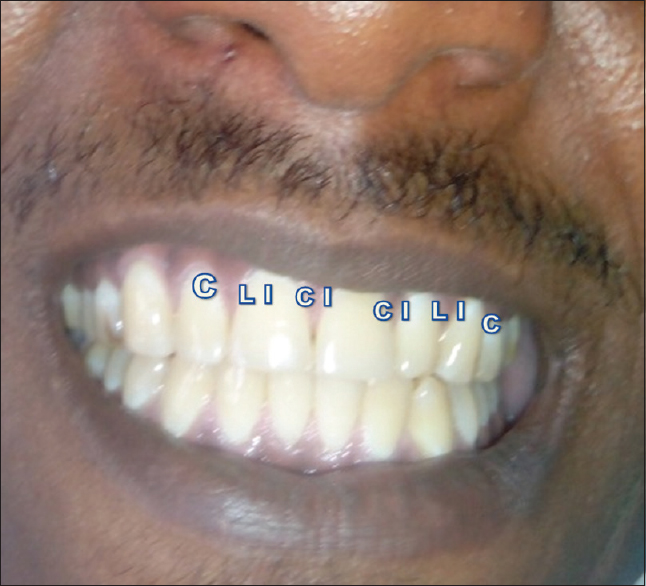 | Figure 6: Six maxillary anterior teeth measured. CI = Central incisor, LI = Lateral incisor, C = Canine
Click here to view |
Descriptive statistics, t-test (to compare mean between genders) and linear regression analysis of height to head circumference, length, and width were conducted. Moreover, multiple regression of height to all head and teeth dimensions was carried out with SPSS 20 (Armonk, New York). P ≤ 0.05 was considered statistically significant.
Informed consent was obtained from subjects, in accordance with World Medical Association Declaration of Helsinki.[23] In addition, the Research Ethics Committee of the College of Health Sciences also approved the research methods.
| Results | |  |
Results indicate that a total of 410 subjects, 18–30 years with mean age 22.31 (SD 4.36) years, participated in the study. The mean age and range for the Efik was 22.17 (SD 3.3.74) years and 18–30 years, respectively; while for the Ibibio, it was 22.45 (SD 4.89) years and 18–30 years, respectively. The distribution of subjects gender-wise is shown in [Figure 1].
In [Table 1], the mean body height, head circumference, length, and width, as well as combined width of maxillary anterior teeth, were significantly higher in males than in females (P < 0.05) among the Efik. In [Table 2], both the body height and head dimensions were significantly higher in males than females (P < 0.05), but the difference between the genders was not statistically significant in the case of combined maxillary anterior crown width (P > 0.05) among the Ibibio.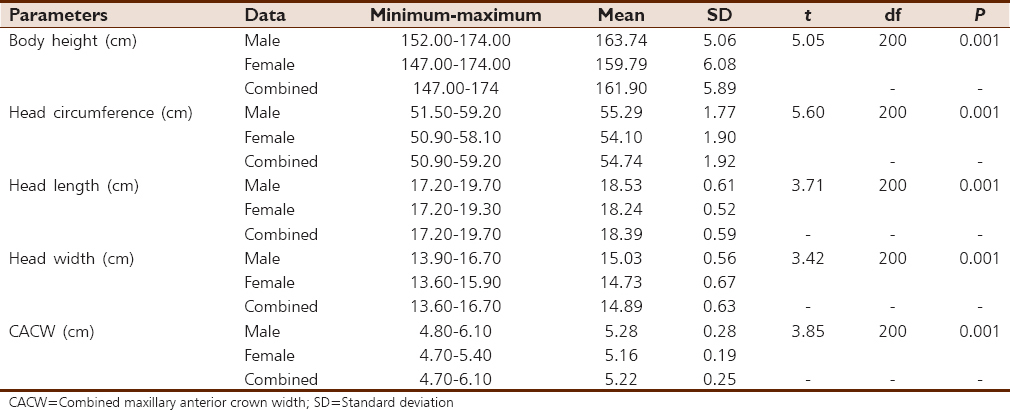 | Table 1: Descriptive statistics and comparison between genders of the parameters measured among the Efik
Click here to view |
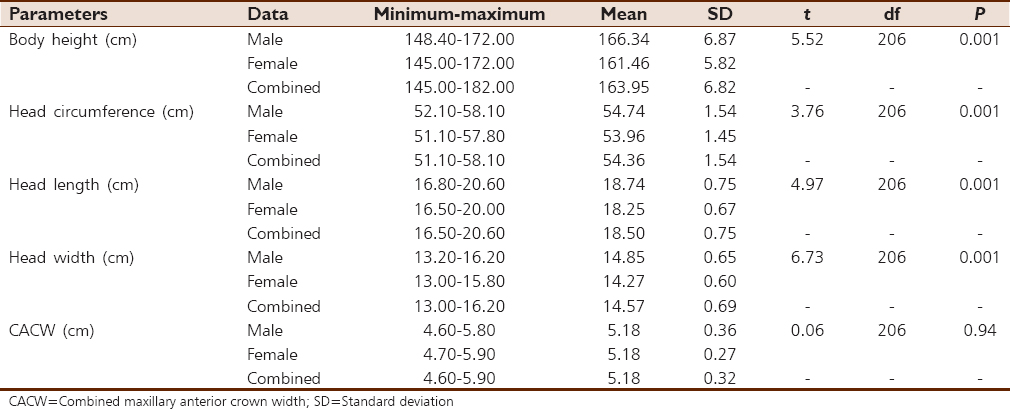 | Table 2: Descriptive statistics and comparison between genders of the parameters measured among the Ibibio
Click here to view |
Pearson's correlation and regression analysis between body height and head circumference were as shown in [Table 3]. Except for female data among the Ibibio, in all data in both the Efik and Ibibio, there was a significant correlation between body height and head circumference (P < 0.05). The values of the variation in the dependent variable (body height) explained by the independent variable (head circumference) (R Square) in both ethnic groups were very low; the highest was in female data among the Efik. The values of the standard error of estimate (SEE) were low among the Efik while they were relatively high among the Ibibio. The regression equations derived from head circumference are shown in [Table 4].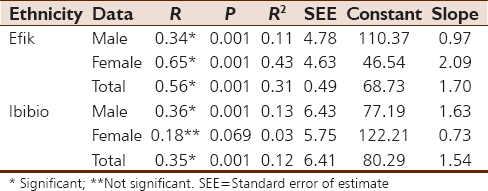 | Table 3: Regression analysis between stature and head circumference in the Efik and Ibibio
Click here to view |
Correlation and regression analysis between body height and head length among the Efik and Ibibio were as presented in [Table 5]. In both ethnic groups, all the data showed a correlation between body height and head dimensions as well teeth dimensions (P < 0.05). The highest value of Pearson's correlation coefficient was in female data among the Efik. In both ethnic groups, the highest value of R square was in the female data among the Efik. Moreover, [Table 6] revealed that the minimum value of standard error of estimates was ≈ 5 in both ethnic groups studied. The regression equations derived from [Table 5] are shown in [Table 4].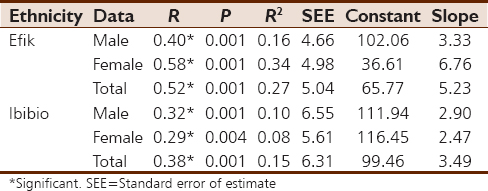 | Table 5: Regression analysis between stature and head length in the Efik and Ibibio
Click here to view |
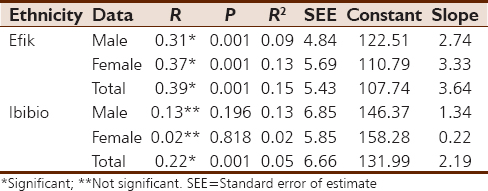 | Table 6: Regression analysis between stature and head width in the Efik and Ibibio
Click here to view |
Pearson's correlation and regression analysis between body height and head width were as presented in [Table 6]. Across the two ethnic groups, all the data, except male and female among the Ibibio, there were significant correlations between body height and stature (P < 0.05); though the values of Pearson's correlation coefficient were very low. The values of R square in all cases were very low. The values of the standard error of the mean were relatively low. The regression equations are shown in [Table 4].
In [Table 7], Pearson's correlation and regression analysis between body height and combined maxillary anterior teeth are shown. Only female data among the Efik, as well as male and female data among the Ibibio, were correlation significant (P < 0.05). Correlation coefficients were low. The values of R square were quite low in all data studied in the two ethnic groups, but SEE was high. [Table 4] shows the regression equations derived from [Table 7].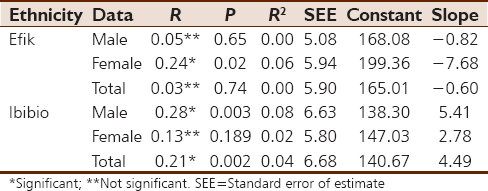 | Table 7: Regression analysis between stature and combined width of maxillary anterior teeth in the Efik and Ibibio
Click here to view |
Multiple regression analysis between body height and combination of head circumference, length, width, and combined crown width of maxillary anterior teeth are presented in [Table 8]. There was a significant relationship between body height and the independent variables in all data in the two ethnic groups. R was highest in female and total data among the Efik. R-square was highest in female data in the Efik. SEEs was high except in female data among the Efik. It was observed that among the Efik, the coefficient of estimates of head circumference, width, and combined crown width in male data; head width in female data; and head width and crown width in combined data were not significant (P > 0.0) and therefore not reliable estimates of the models and were excluded in the models. | Table 8: Multiple regression analysis between stature and all parameters measured in the Efik and Ibibio
Click here to view |
Similarly among the Ibibio, head length and width in male data; head circumference, width, and combined crown width in female data; head circumference and width in combined data; and the coefficient of estimates were not significant (P > 0.05) and therefore not reliable.
| Discussion | |  |
Various factors have been adduced to variations in body dimensions; these could be genetic, environmental, and could be factors specific to the individual population. In the present study, body height in both gender, as well as in the total population of the Ibibio, was higher than in the Efik, in spite of closeness of these ethnic groups. These variations may be multifactorial.
The head dimensions and the dimension of the combined crown width in the two ethnic groups were relatively equal. This observation could be due to the close proximity of the two ethnic groups in regard to geographic location.
Across the two ethnic groups, body height, head dimensions, and combined crown width were significantly greater in males than in females, except combined crown width among the Ibibios. These observations are in agreement with Ukoha et al.[10] who carried out a study on stature estimation from the head circumference, length, and width. In contrast, Jervas et al.[11] reported no significant gender difference in head length and head width. Purohit and Khatri [13] reported a significant gender difference in body height, head length, and width. Shah et al.[24] reported males were significantly greater in body heights, head length, and width than females (P < 0.05). Ilayperuma [2] in their study of stature prediction reported that males were significantly greater in body height, cranial length, and width than females. The observation regarding the combined mesio-distal width of maxillary anterior teeth in this present study is comparable to some previous studies.[14],[25],[26] The above concordance in the majority of the study confirms that the dimensions of body parts in males are higher than in females.
In the present study, regression models were derived from linear regression analyses of stature, with head dimensions and also combined width of maxillary anterior teeth. These regression models were derived only if the linear regression correlation coefficients were significant. In a related study, Ukoha et al.[10] reported a significant correlation between stature, head length, width, and circumference. Purohit and Khatri [13] reported a significant correlation between body height and head length, but the correlation between body height and head width was noted not to be significant. Shah et al.[24] in a related study reported that the correlation between body height and head length, as well as head width, was significant across the population, but similar data in males and females were not significant.
Kumar and Gopichand [5] reported a significant correlation between body height and head length, head width, as well as head circumference. Ilayperuma [2] reported a correlation between stature and cranial dimensions to be statistically significant (P < 0.05). In the majority of data, in this present study, the observation is in accordance with the aforementioned previous studies [2],[5] except head circumference in female data among the Ibibio, head width in male and female data among the Ibibio, combined maxillary anterior crown width in male and combined data among the Efik, and female data among the Ibibio. These variations could be ascribed to factors related to population differences, as well as genetic.
Kalia et al.[14] reported that there were significant correlations between stature and CACW in combined and male data but not significant in female data. Coefficients of correlation were also very poor. Khangura et al.[15] reported poor correlation coefficient between stature and CACW which was also not significant (P > 0.05). Body structures are known to be influenced by gender, environmental, or geographic and genetic factors.
In this present study, the correlation between body height and some parameters was not significant (P > 0.05). This could be due to factors inherent in the ethnic group, data collected, gender, or even unknown factors.
Across the two ethnic groups, in the present study, the proportion of the variance in body height explained by the model as represented by “R-square” was generally low, except head circumference in female and combined data among the Efik, that was, 43% and 31%, respectively; head length in female data among the Efik, that was, 34% and female and combine data among the Efik, that is, 53% and 36%, respectively, using multiple regression analyses. These values are on the low side. In a related study by Shah et al.,[24]R-square was also very low.
This study was limited to young adults in the respective ethnic groups and did put into consideration elderly people in the populations. It is therefore recommended that studies that will include all adult categories should be conducted to account for this limitation.
| Conclusion | |  |
In all the parameters studied in both ethnic groups, the dimensions in males were significantly higher than females, except combined mesiodistal crown width in the Ibibio. In the majority of data studied across the two ethnic groups, there were significant correlations between body height and head circumference, length and width, as well as maxillary anterior crown width. R-square was generally low except in female data among the Efik using multiple regressions of all parameters. In general, the models were not reliable based on the high value of the SEEs. However, these parameters can be employed as supportive tools in stature estimation using regression analysis.
Declaration of patient consent
The authors certify that they have obtained all appropriate patient consent forms. In the form the patient(s) has/have given his/her/their consent for his/her/their images and other clinical information to be reported in the journal. The patients understand that their names and initials will not be published and due efforts will be made to conceal their identity, but anonymity cannot be guaranteed.
Acknowledgment
The author is indeed grateful to all the study subjects for their cooperation.
Financial support and sponsorship
Nil.
Conflicts of interest
There are no conflicts of interest.
| References | |  |
| 1. | Christensen AM, Passalacqua NV, Bartelink EJ. Forensic Anthropology Current Methods and Practice. San Diego, USA: Elsevier; 2014. p. 1-15.  |
| 2. | Ilayperuma I. On the prediction of personal stature from cranial dimensions. Int J Morphol 2010;28:1135-40.  |
| 3. | Agnihotri AK, Kachhwaha S, Googoolye K, Allock A. Estimation of stature from cephalo-facial dimensions by regression analysis in Indo-Mauritian population. J Forensic Legal Med 2011;18:167-72.  |
| 4. | Singh R. Estimation of stature and age from head dimensions in Indian population. Int J Morphol 2013;31:1185-90.  |
| 5. | Kumar M, Gopichand PV. Estimation of stature from cephalo-facial anthropometry in 800 Haryanvi adults. Int J Plant Environ Sci 2013;3:42-6.  |
| 6. | Chaurasia RS, Bamne A, Shukla SN, Gohiya V, Pandey R. Estimation of stature from head length. Int J Med Sci Res Pract 2014;1:40-3.  |
| 7. | Mansur DI, Haque MK, Sharma K, Mehta DK, Shakya R. Use of head circumference as a predictor of height of individual. Kathmandu Univ Med J (KUMJ) 2014;12:89-92.  |
| 8. | Agarwal S, Agarwal SK, Jain SK. Correlation between the stature and cranial measurements in population of North India. Acta Med Int 2014;1:99-102.  |
| 9. | Ekezie J, Anibeze CI, Uloneme GC, Anyanwu GE. Height estimation of the Igbos using cephalo-facial anthropometry. Int J Curr Microbiol Appl Sci 2015;4:305-16.  |
| 10. | Ukoha UU, Umeasalugo KE, Udemezue OO, Asomugha LA. Estimation of stature from cephalic dimensions in a Nigerian population. Rev Argent Anat Clin 2015;7:17-25.  |
| 11. | Jervas E, Anibeze CI, Uloneme GC, Anyanwu GE. Stature estimation of the Igbos using cephalo-facial anthropometry. J Forensic Res 2015;6:295.  |
| 12. | Nemade P, Ambiye M, Nemade A. Regression analysis on stature estimation from cephalic dimensions. Indian J Basic Appl Med Res 2015;4:298-312.  |
| 13. | Purohit N, Khatri JK. Analytical, derivation of regression equation for the estimation of stature from cranial dimensions in Western Rajasthan populations. Int J Anal Pharm Biomed Sci 2015;4:32-6.  |
| 14. | Kalia S, Shetty SK, Patil K, Mahima VG. Stature estimation using odontometry and skull anthropometry. Indian J Dent Res 2008;19:150-4.  [ PUBMED]  |
| 15. | Khangura RK, Sircar K, Grewal DS. Four odontometric parameters as a forensic tool in stature estimation. J Forensic Dent Sci 2015;7:132-6.  [ PUBMED]  |
| 16. | Gupta S, Verma Y, Chandra A, Khanna A, Suhail S, Gupta OP. A study on the reliability of combined width of maxillary anterior teeth, maxillary canine width, head circumference, inner canthal distance, inter-alar width and skull diameter in sex and stature determination. Int J Innov Biol Chem Sci 2015;6:28-35.  |
| 17. | Yadav AB, Yadav SK, Kedia NB, Singh AK. An odontometric approach for estimation of stature in Indians: Cross- sectional analysis. J Clin Diagn Res 2016;10:ZC24-6.  |
| 18. | Pelin C, Zagyapan R, Yazici C, Kürkçüoglu A. Body height estimation from head and face dimensions: A different method. J Forensic Sci 2010;55:1326-30.  |
| 19. | Eboh DE. Stature Estimation using Odontometirc and Cephalometric Parameters among Young Adults in South-South Nigeria. Unpublished Ph.D Thesis, Delta State University, Abraka, Nigeria; 2014.  |
| 20. | Evereklioglu C, Doganay S, Er H, Gunduz A, Tercan M, Balat A, et al. Craniofacial anthropometry in a Turkish population. Cleft Palate Craniofac J 2002;39:208-18.  |
| 21. | Jahanshahi M, Golalipour MJ, Heidari K. The effect of ethnicity on facial anthropometry in Northern Iran. Singapore Med J 2008;49:940-3.  |
| 22. | Farkas LG, editor. Examination. In: Anthropometry of the Head and Face. 2 nd ed. New York: Raven Press; 1994. p. 3-56.  |
| 23. | World Medical Association Declaration of Helsinki: Ethical Principles for Medical Research Involving Human Subjects; 2008. Available from: . [Last accessed on 2016 Jun 18].  |
| 24. | Shah T, Patel MN, Nath S, Bhise RS, Menon SK. Estimation of stature from cephalo-facial dimensions by regression analysis in Gujarati population. J Indian Acad Forensic Med 2015;37:253-7.  |
| 25. | Rahamatulla H, Master SB, Udani TM. Facial measurement and their relationship to the mesiodistal dimensions of the maxillary anterior teeth. J Indian Dent 1979;51:303-6.  |
| 26. | Deogade SC, Mantri SS, Saxena S, Daryani H. Correlation between combined width of maxillary anterior teeth, interpupillary distance and intercimmissural width in a group of Indian people. Int J Prosthodont Restor Dent 2014;4:105-11.  |
[Figure 1], [Figure 2], [Figure 3], [Figure 4], [Figure 5], [Figure 6]
[Table 1], [Table 2], [Table 3], [Table 4], [Table 5], [Table 6], [Table 7], [Table 8]
|